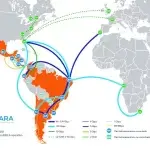Unlocking the Potential: Palm Oil in Latin America

eyesonbrasil
Latin America, a region rich in biodiversity and agricultural resources, has emerged as a significant player in the global palm oil industry. With its lush landscapes and favorable climate, it’s no surprise that palm oil production has gained momentum here. In this article, we explore the untapped potential of palm oil in Latin America, focusing on Brazil, and delve into its health implications.
1. The Rise of Latin America in Palm Oil Production
A Growing Force
Latin America stands as the second-largest palm oil producing region worldwide, contributing a robust 5.7% of the global palm oil supply1. Among the key players, Colombia leads the charge, followed closely by Ecuador, Honduras, Guatemala, Brazil, and Costa Rica1. These countries have harnessed their fertile lands and favorable climates to cultivate oil palm trees, yielding substantial harvests.

2. Brazil’s Opportunity: A Green Gold Rush
The Brazilian Advantage
Brazil, with its vast agricultural expanse, is uniquely positioned to capitalize on palm oil production. Here’s how agribusiness in Brazil can seize this opportunity:
- Land Utilization: Brazil boasts extensive underutilized land, ideal for oil palm cultivation. By strategically allocating these areas, Brazil can significantly boost its palm oil output.
- Sustainable Practices: Embracing sustainable practices is crucial. Brazil can lead the way by implementing eco-friendly cultivation methods, minimizing deforestation, and promoting biodiversity conservation.
- Investment in Research: Collaborating with research institutions to enhance oil palm varieties, disease resistance, and yield optimization will propel Brazil’s palm oil industry forward.
- Export Potential: Brazil can tap into the growing global demand for sustainable palm oil. By adhering to responsible production standards, it can become a major exporter.
Read also: The Palm Oil Revolution: Latin America’s Rise and Malaysia’s Mettle (eyesonmalaysia.com)
3. The Health Quandary: Palm Oil’s Pros and Cons
Balancing the Scales
Palm oil’s health impact remains a topic of debate. Let’s weigh the scales:
Pros:
- Energy Boost: Rich in calories, palm oil provides a quick energy source.
- Antioxidants: It contains vitamin E and carotenoids, which combat oxidative stress.
- Vitamin K: Essential for blood clotting and bone health.
- Supports Pregnancy: Palm oil’s vitamin A content benefits fetal development.
Cons:
- Saturated Fat: Nearly half of palm oil’s calories come from saturated fat. Excessive consumption may raise LDL cholesterol levels.
- Toxicity Concerns: When heated, palm oil produces glycidol, a potential carcinogen. However, research is inconclusive2.
4. Conclusion: Nurturing Growth and Wellness
Harvesting Hope
As Brazil embraces its role in the palm oil saga, it must tread thoughtfully. Balancing economic prosperity with environmental stewardship and health consciousness is the key. Let us envision a future where palm oil sustains livelihoods, nourishes bodies, and protects our planet. Together, we cultivate not just oil palms but also hope for a greener, healthier world.
Remember, every seed planted today bears fruit for generations to come.
Sources:
- Sustainable palm oil in Latin America – from strength to strength1
- Palm oil production in Latin America by country 2023 | Statista3
- Palm Oil: Comparing the Positives and Negatives – Verywell Health2







